Unity Health Care
Diabetes and Depression Screening
Unity Health Care is the largest network of federally-qualified community health centers in Washington, D.C. They provide a full range of health and human services at over 20 traditional and non-traditional health sites serving 104,000 patients and 500,000 visits annually. Deeply rooted in the District’s neighborhoods for more than 30 years, Unity strives to promote healthier communities through compassionate and comprehensive primary and specialty health care and wrap-around services, regardless of ability to pay.
Upper Cardozo Health Center, a Unity center, serves as a medical home to nearly 26,000 patients. Their patient population is low-income and mostly immigrant. More than 2,500 of Upper Cardozo adult patients have diabetes, accounting for approximately 25% of all Unity Health Care diabetes patients.
According to the World Health Organization, the number of people with diabetes has risen from 108 million in 1980 to 422 million in 2014. Adults with diabetes have a two- to three-fold increased risk of heart attacks and strokes and combined with reduced blood flow, neuropathy (nerve damage) in the feet increases the chance of foot ulcers, infection and eventual need for limb amputation. Improving diabetes care at Upper Cardozo would have a direct impact on the long-term health outcomes of their patients.
In addition, approximately 17,000 patients at Upper Cardozo Health Center 12 years and over should be screened for depression every year. In 2017, Upper Cardozo ranked last among all Unity health centers for depression screening and follow-up tracking at only 33% of patients. An Agency for Healthcare Research and Quality (AHRQ) meta–analysis, looking at patients with depressive symptoms or diagnosed depressive disorders in primary care settings, showed that collaborative care interventions have a positive effect on medication adherence and depressive symptoms.
The Performance Improvement Challenge
Unity Health Care created a Performance Improvement Challenge for the Upper Cardozo HC to improve depression screening and follow up and the quality of care for diabetes patients. Their challenge goals included:
- Increase diabetes foot exam rates for diabetes patients from 42% to 50% and,
- Become one of the leading Unity Health Care centers for depression screening and follow up.
An Azara DRVS user since 2017, a key component of the Performance Improvement Challenge was to use DRVS and its Visit Planning Report to identify patients, track and perform screenings, and measure health center progress.
The DRVS Visit Planning Report is an electronic list of essential data for patients with upcoming appointments. The report displays only relevant and actionable items to help health center care teams prepare for visits and shows all patients with appointments and alerts, such as screenings, in one single view. It is ideal for care team huddles and replaces the work medical assistants (MAs) and licensed practical nurses (LPNs) do manually with EHR data and configurable care alerts.

Putting Visit Planning to Work
To make the Performance Improvement Challenge a bit more fun, leaders created a competition among its color-coded care teams that include medical assistants and providers. Standard operating procedures for depression screening – PHQ2, PHQ9, and Edinburgh post-partum depression screening tools – were implemented and MAs were trained to perform monofilament examinations on diabetes patients since podiatrists are on site at Upper Cardozo. MAs were given Azara DRVS user accounts and pulled Visit Planning Reports daily that included alerts for diabetes patients needing foot exams, and for all patients 12 years and older requiring depression screening. Custom, team-based dashboards created in DRVS were used to track each team’s Challenge progress to help drive motivation and competitiveness.
Through the Performance Improvement Challenge reporting, emerging disparities among the diabetes patients cared for by the color-coded teams were tracked using DRVS. At the beginning of the Challenge, the Visit Planning Report was not used by all MAs due to the perception that the information provided would not improve patient care at the center. Using DRVS, Cardozo reported a strong correlation to the use of the Visit Planning Report and improved diabetes foot exam rates, and by March 2018, all medical assistants were using Visit Planning Report for their clinical operations.
Results
Unity achieved the performance improvements they set out to achieve through the routine use of Visit Planning Reports by medical assistants. Improvement statistics include:
- More than 50% of Upper Cardozo diabetes patients seen in 12 months became up-to-date on their foot exam, compared to approximately 30% prior to the challenge. Improvements have been sustained after completion of the team challenge.
- Depression screening and follow-up rates improved across all teams increasing from 35% to 63%. These improvements continued to greater than 70% and have been sustained after completion of the team challenge as well.
- Per month, depression screening rates improved by 81-89% for approximately 400-500 patients per month, per team.
The use of custom team-based dashboards created in DRVS and an approach incorporating all care team members in a friendly competition made improvement work fun and ramped up the care team engagement. Today, Unity continues to use the actionable data DRVS provides along with Visit Planning Reports to care for and improve the lives of more than 100,000 patients.
